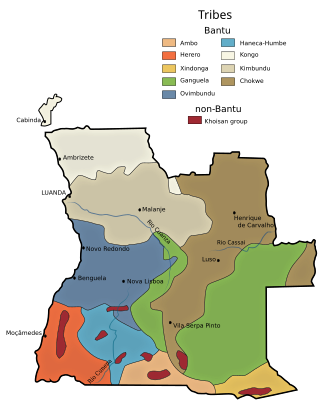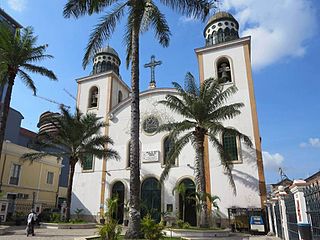Related Research Articles

The culture of Angola is influenced by the Portuguese. Portugal occupied the coastal enclave Luanda, and later also Benguela, since the 16th/17th centuries, and expanded into the territory of what is now Angola in the 19th/20th centuries, ruling it until 1975. Both countries share cultural aspects: language (Portuguese) and main religion. However, present-day Angolan culture is mostly NATIVE Bantu, which was mixed with Portuguese culture. The diverse ethnic communities with their own cultural traits, traditions and native languages or dialects include the Ovimbundu, Ambundu, Bakongo, Chokwe, Avambo and other peoples.

The Cuanza Norte Province is province of Angola. N'dalatando is the capital and the province has an area of 24,110 km² and a population of 443,386. Manuel Pedro Pacavira was born here and is a former provincial governor. The 1,400 meter long Capanda Dam is located in this province. Cuanza Norte lies on the northern bank of the Cuanza River. It had been a territory of Ngola Kingdom. In 1914, Norton de Matos created District of Cuanza which was divided into Cuanza Norte and Cuanza Sul Provinces in 1917.

Cuanza Sul Province is a province of Angola. It has an area of 55,660 square kilometres (21,490 sq mi) and a population of 1,881,873. Sumbe is the capital of the province. Dom Francisco Inocêncio de Sousa Coutinho founded the province in 1769 as Novo Redondo.

Candomblé Bantu is one of the major branches (nations) of the Candomblé religious belief system. It developed in the Portuguese Empire among Kongo and Mbundu slaves who spoke Kikongo and Kimbundu languages. The supreme and creative god is Nzambi or Nzambi a Mpungu. Below him are the Jinkisi or Minkisi, deities of Bantu mythology. These deities resemble Olorun and the other orishas of the Yoruba religion. Minkisi is a Kongo language term: it is the plural of Nkisi, meaning "receptacle". Akixi comes from the Kimbundu language term Mukixi.
Angolan Portuguese is a group of dialects and accents of the Portuguese language used mostly in Angola, where it is an official language. In 2005 it was used there by 60% of the population, including by 20% as their first language. The 2016 CIA World Fact Book reports that 12.3 million, or 47% of the population, speaks Portuguese as their first language. However, many parents raise their children to speak only Portuguese. The 2014 census found that 71% speak Portuguese at home, many of them alongside a Bantu language, breaking down to 85% in urban areas and 49% in rural areas.

The Ovimbundu, also known as the Southern Mbundu, are a Bantu ethnic group who live on the Bié Plateau of central Angola and in the coastal strip west of these highlands. As the largest ethnic group in Angola, they make up 38 percent of the country's population. Overwhelmingly the Ovimbundu follow Christianity, mainly the Igreja Evangélica Congregacional de Angola (IECA), founded by American missionaries, and the Catholic Church. However, some still retain beliefs and practices from African traditional religions.

Ipala is a town and municipality in the Chiquimula department of Guatemala.

Kimbundu, a Bantu language which has sometimes been called Mbundu or 'North Mbundu', is the second-most-widely-spoken Bantu language in Angola.

The Pala dynasty of Kamarupa kingdom ruled from 900 CE. Like the Pala Empire of Bengal, the first ruler in this dynasty was elected, which probably explains the name of this dynasty "Pala". But unlike the Palas of Bengal, who were Buddhists, the Palas of Kamarupa were Hindus. The Hindu orthodoxy drew their lineage from the earlier Varman dynasty and thus ultimately from Narakasura i.e. Bhauma dynasty. The dynasty is unrelated to the previous Varman and Mlecchna dynasty.

Portuguese is the only official language of Angola, but 46 other languages are spoken in the country, mostly Bantu languages. Six of these have the benefit of an institutional status in Angola: Umbundu, Kimbundu, Kikongo, Chokwe, Ngangela and Kwanyama.

The Ambundu or Mbundu (Mbundu: Ambundu or Akwambundu, singular: Mumbundu are a Bantu people living in Angola's North-West, North of the river Kwanza. The Ambundu speak Kimbundu, and most also speak the official language of the country, Portuguese. They are the second biggest ethnic group in the country and make up 25% of the total population of Angola.

Portuguese Angolan is a person of Portuguese descent born or permanently living in Angola. The number of Portuguese Angolans dropped during the Angolan War of Independence, but several hundreds of thousands have again returned to live and work in Angola in the 21st century.
Angolanidade is the national identity of Angola. It can also be described as Angolan cultural patriotism. Much of what is today considered angolanidade was created by Angolan intellectuals as a conscious effort to highlight an idealized vision for what it means to be Angolan.
Mbundu may refer to:
The Kavango – Southwest Bantu languages are a group of Bantu languages established by Anita Pfouts (2003). The Southwest Bantu languages constitute most of Guthrie's Zone R. The languages, or clusters, along with their Guthrie identifications, are:
The Kimbundu languages are a group of Bantu languages coded Zone H.20 in Guthrie's classification. According to Nurse & Philippson (2003), they probably form a valid node, though this is still uncertain. They are:
Kuvale is a Southern Bantu language spoken in Angola, in the middle of a large Umbundu-speaking area. It has traditionally been considered a dialect of Herero; however, Maho (2009) has moved it from Bantu Zone R.30 to Zone R.10, which includes Umbundu and a few smaller languages. Ngendelengo may be a distinct language.
Bolo, also known as Ngoya and Kibala, is a Bantu language of Angola that is closely related to Kimbundu.
Mbali is a minor Bantu language of Angola, spoken on the coast on the southern edge of the large Umbundu-speaking area and the northern end of the uninhabited Namib desert. Its classification is unclear. Arends et al. suggest it might turn out to be a Kimbundu–Umbundu mixed language, though it is nowhere near Kimbundu territory.
References
- 1 2 Angenot et al. (2013) "Comparison between the Ipala-Ngoya, Kimbundu and Umbundu tone-class systems", Revista Língua Viva vol. 3, no. 1.
- ↑ Jouni Filip Maho, 2009. New Updated Guthrie List Online